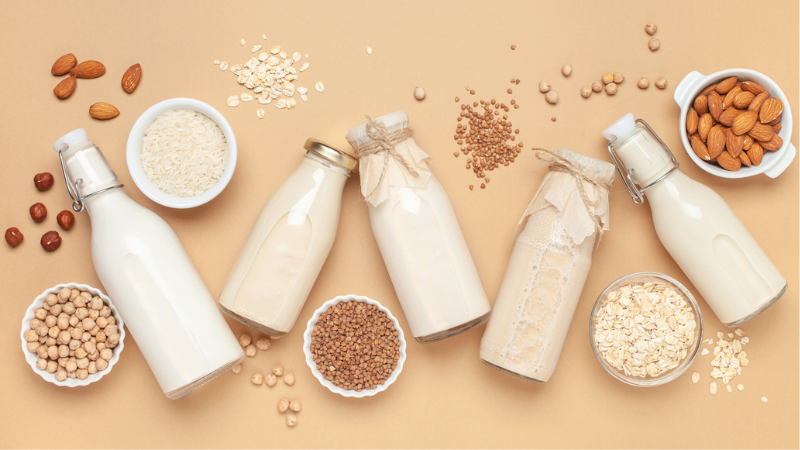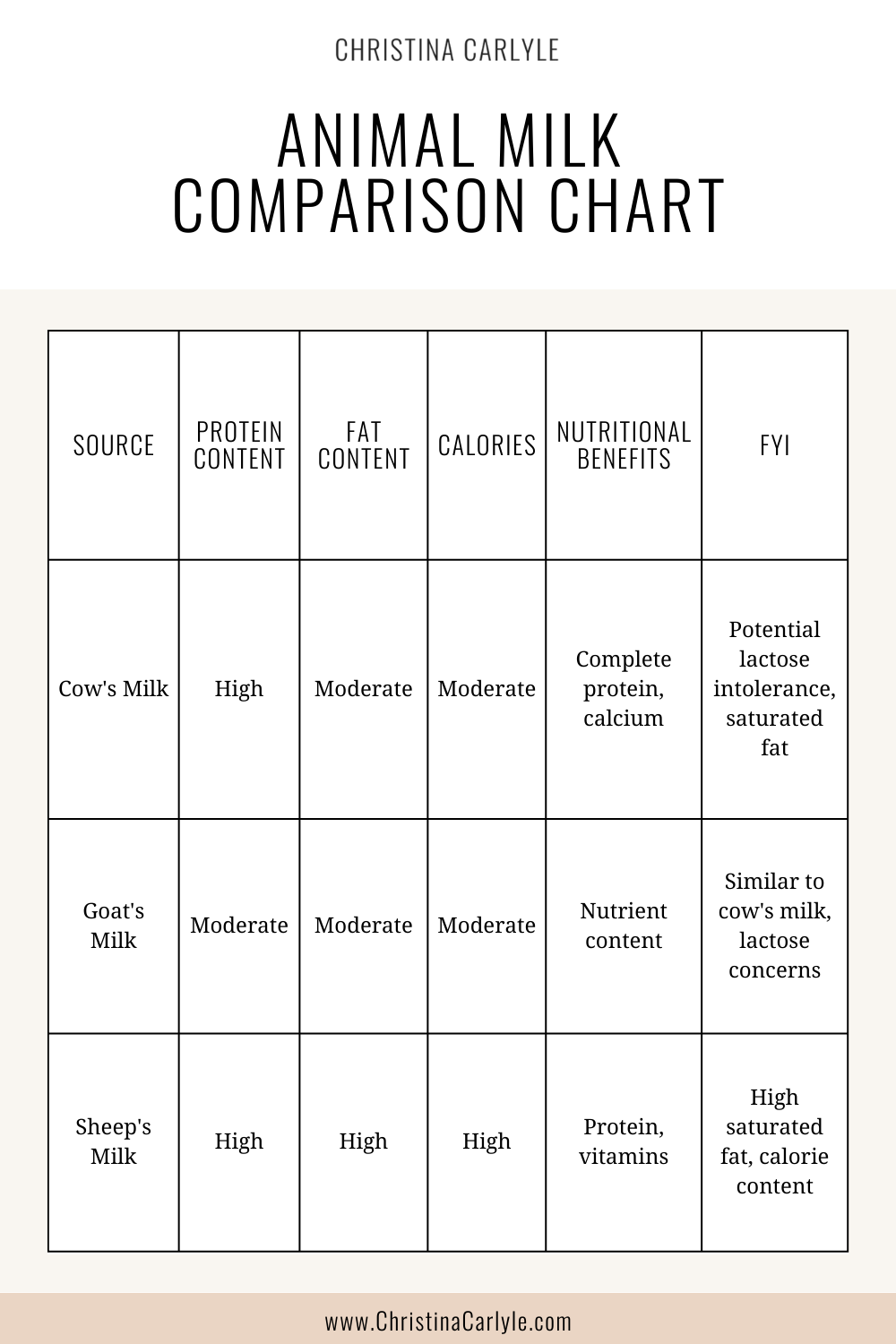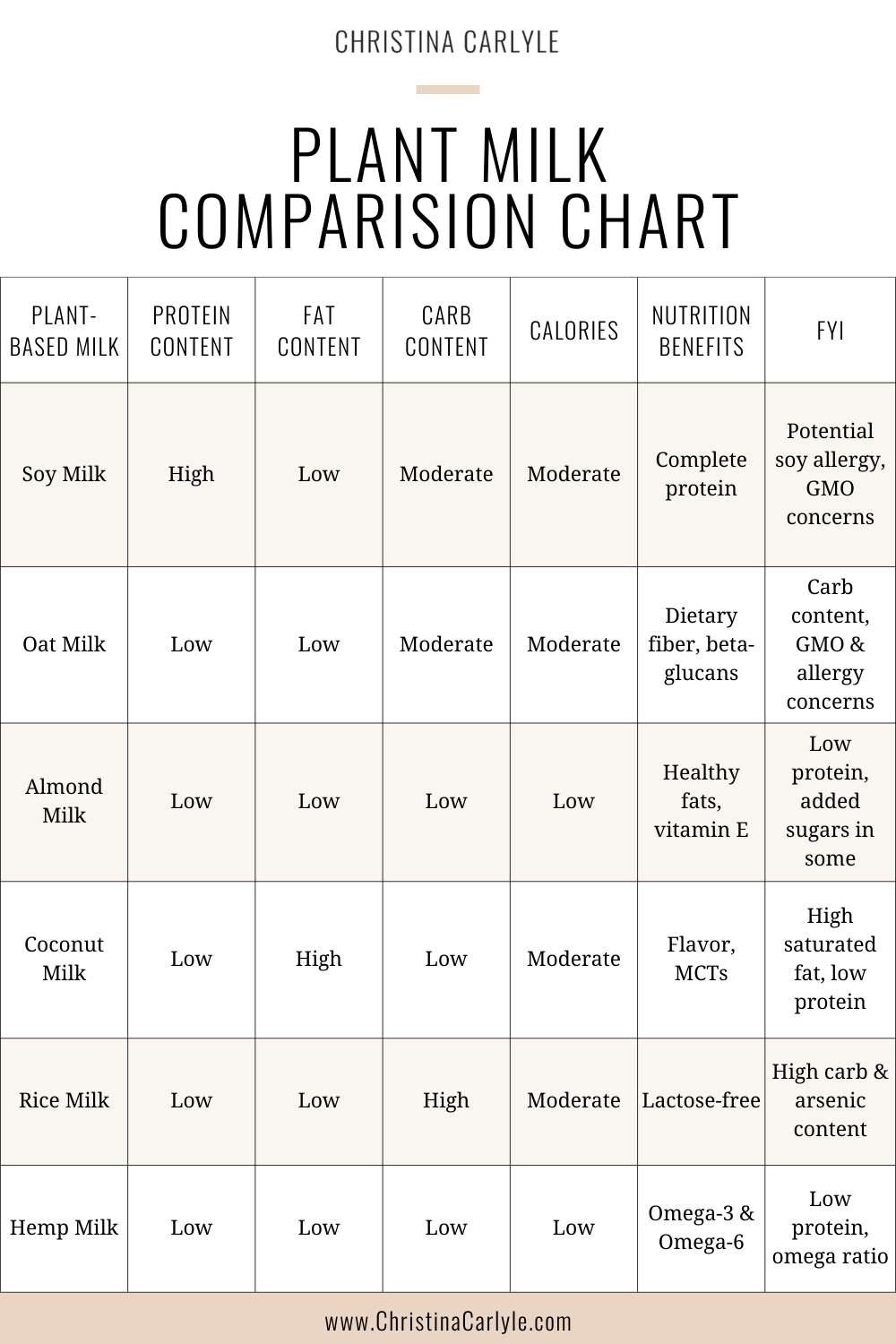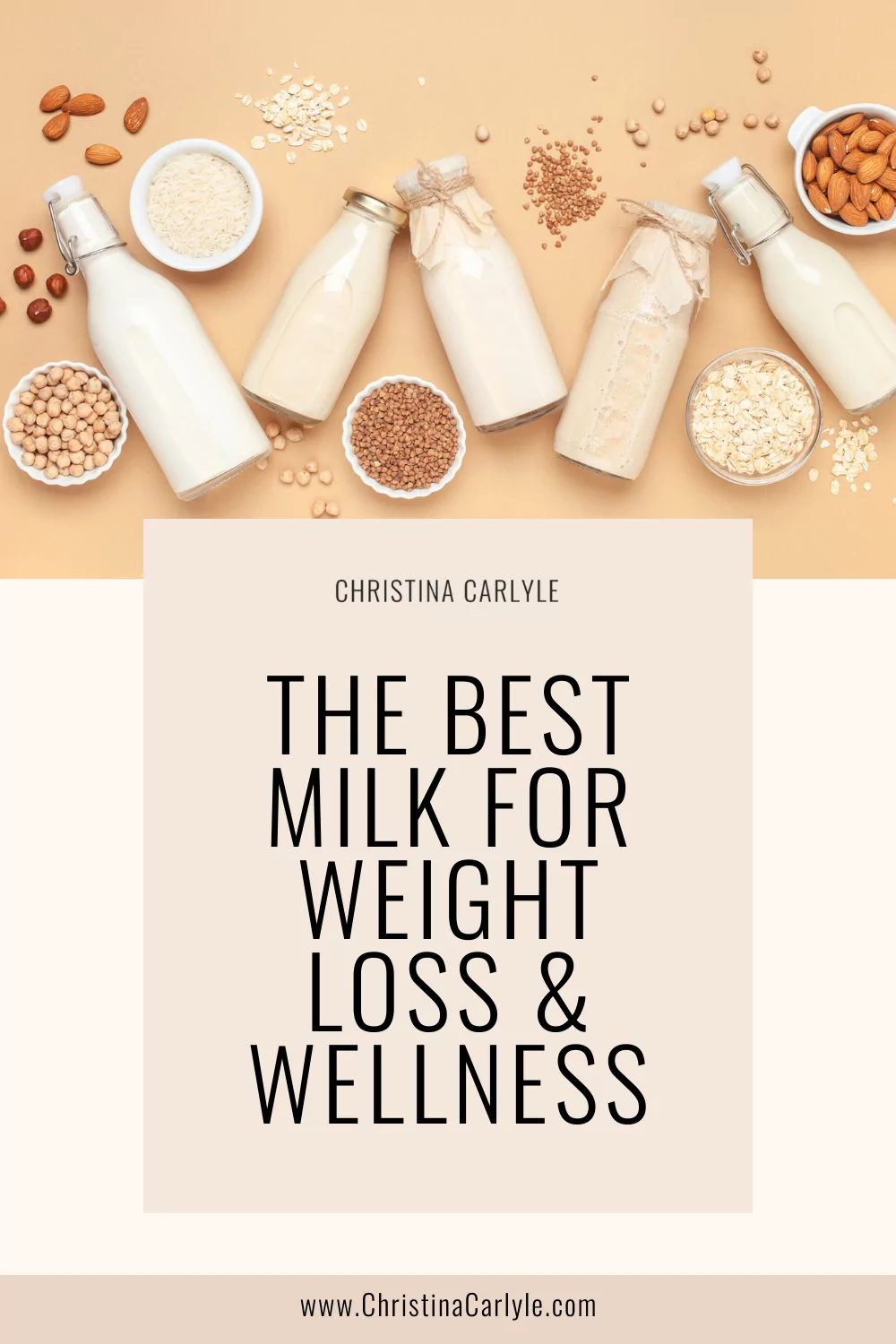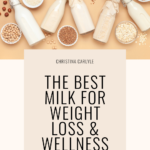Last Updated on August 14, 2023
One of the most common questions I get is what is the best milk for weight loss and wellness.
Once upon a time, cow’s milk was the only option but times have changed! With options like cow, sheep, goat, almond, soy, coconut, oat, raw, pasteurized, and carrageenan free (or not) – choosing the right milk for you can be confusing.
That’s why I put together this guide to the best milk for fitness and health so you can choose the best milk for you.
I’ll be covering the most common/popular kinds of milk, their pros, cons, tips to tell which milk is right for you, and the top 3 types/brands of milk I recommend most.
Let’s dig in!
Determining whether animal milk or plant-based milk are healthier depends on various factors, including individual dietary preferences, health goals, and potential health concerns. Both options have their own set of nutritional benefits and considerations. The first thing to consider is the source of your milk.
Animal Vs. Plant-based Milk
There are two main ‘categories’ of milk: animal and plant sources. Each has its own set of pros and cons. This is a rundown of the general characteristics of the 2 main sources.
Animal Milk (Cow, Goat, Sheep, Camel, (Yes, camel milk is a thing)):
Pros:
- Excellent source of complete protein, containing all essential amino acids necessary for the body.
- Also contains some fat, which can help with satiety.
- Rich in calcium, which is important for bone health.
- Naturally contains nutrients like vitamin B12 and vitamin D.
- Some kinds of animal milk are fortified with additional nutrients like vitamin A and vitamin D… but this doesn’t mean that they’re natural (they can be synthesized) you’ll absorb it… especially if you’re reactive to dairy
- Raw milk is best as it contains live nutrients.
- Pasteurization kills nutrients and beneficial microbes.
Cons:
- Contains saturated fat, which can contribute to heart health concerns and weight gain.
- Is designed to make a baby cow (or goat, sheep, etc.) grow from 100 pounds to 100’s – 1000+ pounds…
- Lactation of animals is induced by hormones so the animal will produce milk. The hormones leach into the milk and then into you. Even if you’re drinking organic milk, natural hormones may still be present… all of which are intended for the growth and development of said animal… not necessarily a human.
- This may lead to digestive discomfort in individuals with lactose intolerance or milk allergies.
- Approx. 70% of the global adult human population has some sort of lactose intolerance, which results in abdominal pain, other gastrointestinal consequences and symptoms (like fatigue, bloat, post nasal drip, inflammation, and skin issues) after eating dairy products.
- Allergies and intolerances vary by race. 70 to 100% of the population with East Asian heritage have issues digesting lactose. Approx. 75 to 90% of Native Americans, African Americans, Asians, Mediterraneans, and Jewish people have intolerance. While only about 5% of Northern and Central Europeans have lactose intolerance.
- There are concerns about the ethical and environmental impact and animal welfare associated with large-scale dairy production. Commercial dairy cows are poorly treated and often fed a GMO diet, making them nutrient deficient so milk doesn’t contain the calcium, minerals, and vitamins as the packaging claims.
- Nutrients found in milk expire quickly the longer they’re exposed to light and air. So if your milk jug is opaque/clear and stored under light – essentially you’re drinking craving & inflammation-inducing water that’s high in sugar, fat, and hormones (and those hormones can affect your hormones)…
- Contain lactose and casein, both of which cause cravings, blood sugar fluctuations, and hunger. Milk contains casein, a dairy protein that releases casomorphins, which are plant compounds that trigger dopamine production in your brain similar to opiates. This makes milk (and all dairy) addictive.
If you’re the type of person that eats cheese/drinks milk and craves it (like me!) – I recommend avoiding animal milk completely. Cravings for milk/dairy mean you’re having an adverse reaction. Typically an allergic, inflammatory, autoimmune, or sensitivity reaction. All of which affect gut health, inflammation, cravings, weight, and immunity.
Now let’s break down the pros and cons of the different plant-based milk…
Plant-Based Milks (Almond, Soy, Oat, & Coconut Milk):
- Pros:
- Generally lower in calories and saturated fat compared to animal milk. So they don’t contribute to macros (proteins, carbs, and fats) or much to calorie count making them great for weight loss.
- Great options for individuals with lactose intolerance, milk allergies, or ethical considerations about animal products.
- Cons:
- Often lower in protein than animal milk, although some plant milks like soy offer comparable protein content.
- Nutrient content can vary widely based on the brand and fortification.
- Some plant kinds of milk may contain added sugars or thickening agents, so reading labels is important.
- Individuals with certain allergies, like nut allergies, need to choose plant milk carefully.
That’s a general overview of animal versus plant milk.
Is raw or pasteurized milk healthier?
For animal milk, the next line of questioning (from a professional nutrition standpoint) is if the milk is raw or pasteurized.
Both methods have their own set of pros and cons to consider to see if it’s a good fit.
Raw Milk:
- Nutritional Content: Advocates of raw milk argue that it contains higher levels of certain nutrients and enzymes, as well as beneficial bacteria that can be destroyed during pasteurization. However, there’s limited scientific consensus on whether the nutritional differences are significant enough to make a substantial impact on health.
- Probiotics: Raw milk does contain naturally occurring bacteria, some of which could potentially have probiotic benefits. However, the types and amounts of bacteria present can vary widely and might not provide consistent probiotic benefits.
- Health Benefits: Supporters of raw milk claim that it can boost the immune system, improve digestion, and alleviate allergies. However, scientific evidence supporting these claims is limited, and there are potential risks associated with consuming raw milk. The sale of raw milk is regulated in many jurisdictions due to the potential health risks associated with consuming unpasteurized milk… so depending on where you’re located, you may not be able to buy it legally.
Pasteurized Milk:
- Nutritional Content: Pasteurization involves heating milk to kill harmful pathogens while preserving most of its nutritional value. While some heat-sensitive nutrients might be slightly reduced, pasteurized milk remains a good source of protein, calcium, and other essential nutrients.
- Probiotics: Pasteurization destroys harmful bacteria, but it can also eliminate beneficial bacteria. Some commercial pasteurized milk products are fortified with probiotics after pasteurization to enhance their health benefits.
- Health Benefits: Pasteurization significantly reduces the risk of foodborne illnesses by eliminating harmful bacteria such as Salmonella, E. coli, and Listeria. This is especially important for vulnerable populations like children, elderly individuals, and those with weakened immune systems.
- Raw milk carries a higher risk of contamination by harmful bacteria, viruses, and parasites, which can cause severe illnesses. Pasteurization effectively eliminates these risks. In some case
Because animal milk has more cons, less nutrients, can cause cravings/addiction, and is literally NOT intended for human consumption, I do NOT recommend drinking them. I don’t know any holistic health practitioner that does, with the exception of raw milk.
]BUT I still do not recommend raw milk because 1) it’s hard to find, 2) may be illegal in your state, 3) can contain pathogens, and 4) it can cause cravings, adverse reactions, and inflammation. It’s way easier and safer to take probiotics to get the live cultures of beneficial microbes contained in raw milk. With probiotics, you’ll get all the benefits without risks.
If you do decide to drink animal milk, make sure you’re choosing organic options to avoid consuming hormones.
Also, it’s best to max out at 1, 8-ounce serving a day. Any more increases the risk of inflammation, cravings, and addiction in addition to racking up calories, saturated fat, and sugar.
Is plant or animal milk better for weight loss?
For weight loss and health purposes, I always recommend plant-based options of milk because animal sources aren’t as nutritious as you may be led to believe… I also don’t recommend it because dairy is highly reactive for both allergies/sensitivities and inflammation.
For weight loss and wellness, I always recommend plant-based options.
But even plant-based options have their own pros and cons.
I’m ranking the main types of plant milk from best to worst for weight loss and overall wellness. I’ve ranked them based on various factors, including nutrient content, potential health benefits, and their impact on weight and health.
Here’s a general ranking, considering these factors, potential problems, and things to look out for on product packaging:
Soy Milk:
- High-quality protein content, comparable to cow’s milk.
- Contains all essential amino acids, making it a complete protein source.
- Beneficial for weight management due to its satiating effect and potential to control appetite.
- Potential heart health benefits due to its low saturated fat content and the presence of heart-healthy unsaturated fats.
- Phytochemicals in soy have been linked to the potential reduction in chronic disease risk.
- Soy is typically genetically modified. So it’s best to choose GMO-free, organic soy milk options.
Oat Milk:
- Creamy texture and pleasant taste.
- Provides dietary fiber, which can aid in digestion and satiety.
- Beta-glucans in oats may help lower cholesterol levels.
- Typically fortified with nutrients like calcium and vitamin D.
- Oats are typically genetically modified. So make sure you choose GMO-free, organic oat milk options.
Almond Milk:
- Low in calories and saturated fat, suitable for weight management.
- Contains healthy monounsaturated and polyunsaturated fats.
- Provides vitamin E, an antioxidant that supports skin health.
- Naturally lactose-free and suitable for those with lactose intolerance.
- Almonds aren’t GMO but often contain carrageenan, which is a common thickening agent used in almond milk. Carrageenan is carcinogenic… and even if you get an organic option it can legally still contain carrageenan here in the United States. So always opt for carrageenan-free options.
Coconut Milk:
- Creamy and flavorful, adding variety to recipes.
- Provides medium-chain triglycerides (MCTs), which can have potential health benefits.
- However, it’s high in calories and saturated fat compared to others, so moderation is recommended for heart health.
There are a few types of coconut milk to be aware of.
- Canned coconut milk – This comes in a can and is typically one part coconut (water & flesh) blended with two parts water. Consistency is thinner. Used for cooking.
- Canned coconut cream – typically four parts coconut flesh to one part water. Consistency is thicker and creamier. Used for cooking.
- Carton/bottled coconut milk beverage – very small amounts of coconut flesh to water. Fortified with vitamins. Best for drinking and as a cow/animal milk alternative in recipes.
Rice Milk:
- Generally low in allergens, making it suitable for individuals with allergies or sensitivities.
- Often higher in carbohydrates and lower in protein compared to other plant-based milks.
- Typically fortified with nutrients like calcium and vitamin D.
- Rice is high in inorganic arsenic and overconsumption of rice milk can easily have you overconsuming safe limits.
- Can be hard to find.
Hemp Milk:
- Contains omega-3 and omega-6 fatty acids, beneficial for heart and brain health.
- May provide some protein but lower compared to soy or pea milk.
- Often fortified with nutrients.
- Isn’t the best tasting.
- Can be hard to find.

Making Milk vs. Store-Bought Options
The best plant milks are homemade. Nut milk is very easy to make – use this nut milk tutorial.
But I know that’s not always realistic or budget-friendly…
When buying store-bought plant milks always get the carrageenan-free, unsweetened, and unflavored options of the following brands. (PS This is NOT sponsored. I am not affiliated with nor being compensated by these brands in any way.)
- Califia (plain, unsweetened)
- So Delicious (plain, unsweetened)
- Best on a budget: Silk (plain, unsweetened)
The ‘natural’ flavors added to milk aren’t always clean… often times they’re made from synthetic chemicals. So instead of getting flavored options, add your own flavorings at home to create the flavors and sweetness you want. Vanilla extract, hazelnut, cinnamon, and stevia are my go-to’s for flavoring milk. Add to taste, stir in, and enjoy!
I hope this helped clear up the confusion about which milk is best for weight loss and health.
Which type is your favorite? Let me know in the comments.
xo
Your Coach & Biggest Cheerleader,
![]()
Pin this to Pinterest so you’ll have it forever
If you liked this article you’ll love everything else in my Best Foods for Weight Loss Series
- Best Healthy Cooking Oils
- Best Protein Powders for Weight Loss
- Best Supplements for Weight Loss
- Best Fruits for Weight Loss
- Best Vegetables for Weight Loss
- Best Nuts for Weight Loss
- Best Carbs for Weight Loss

